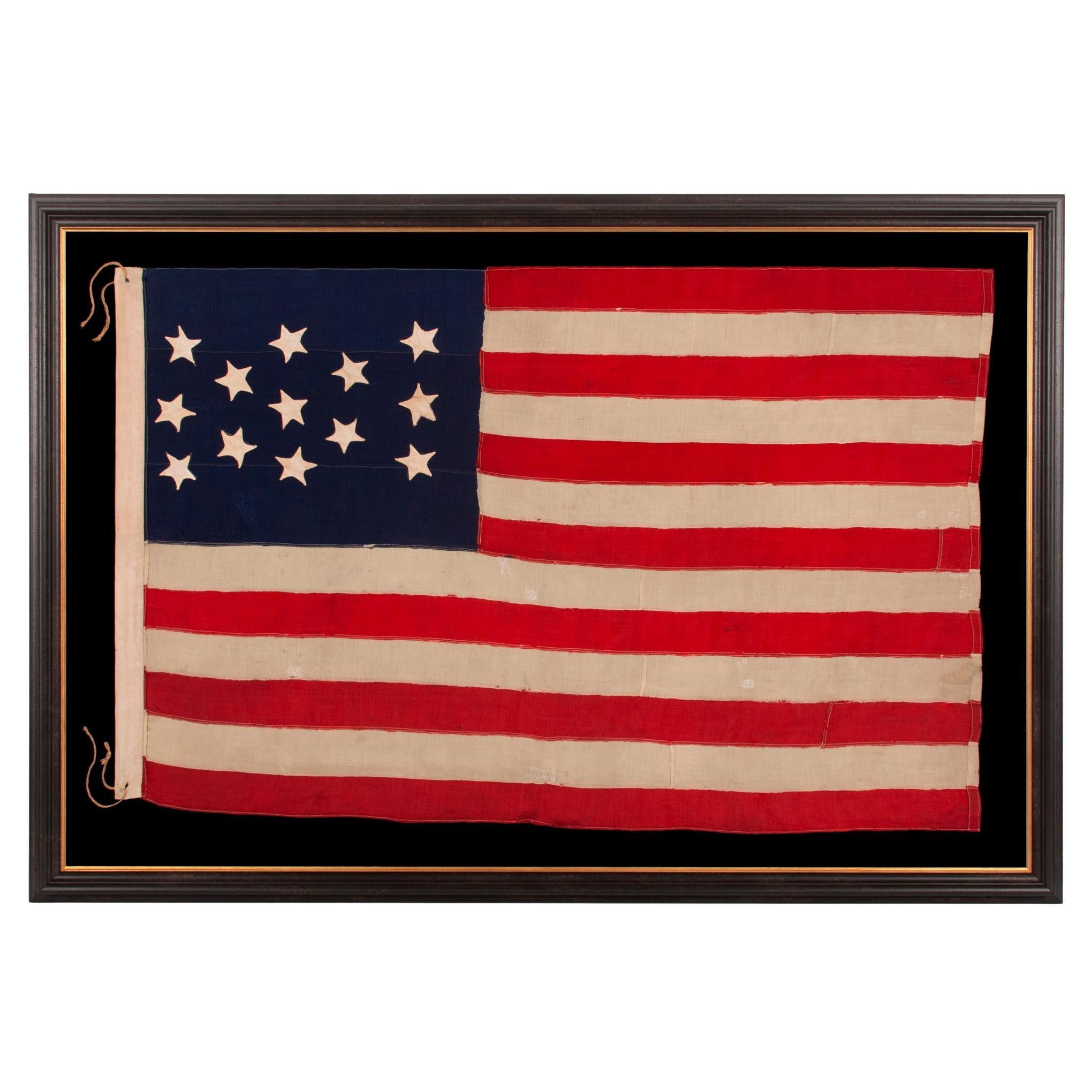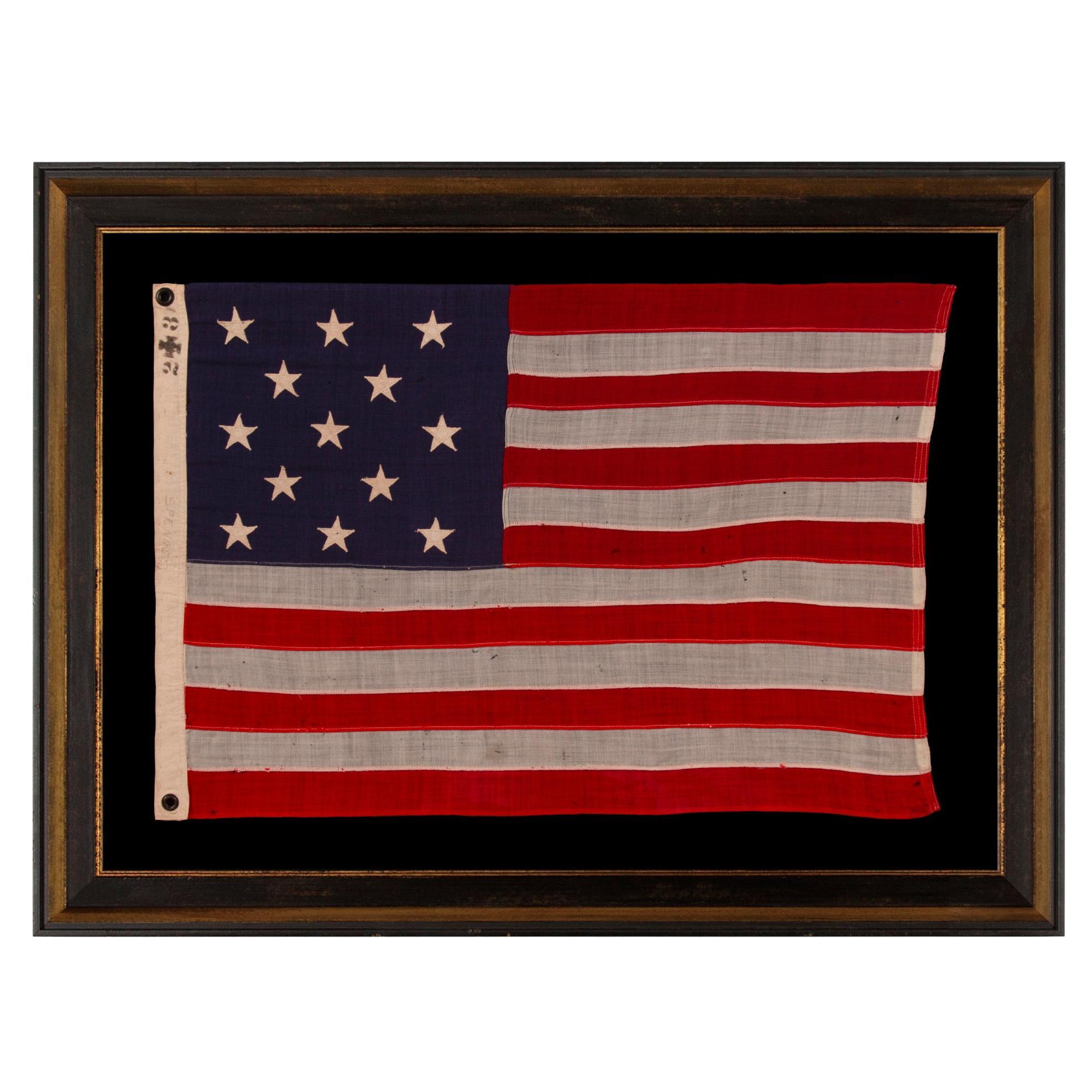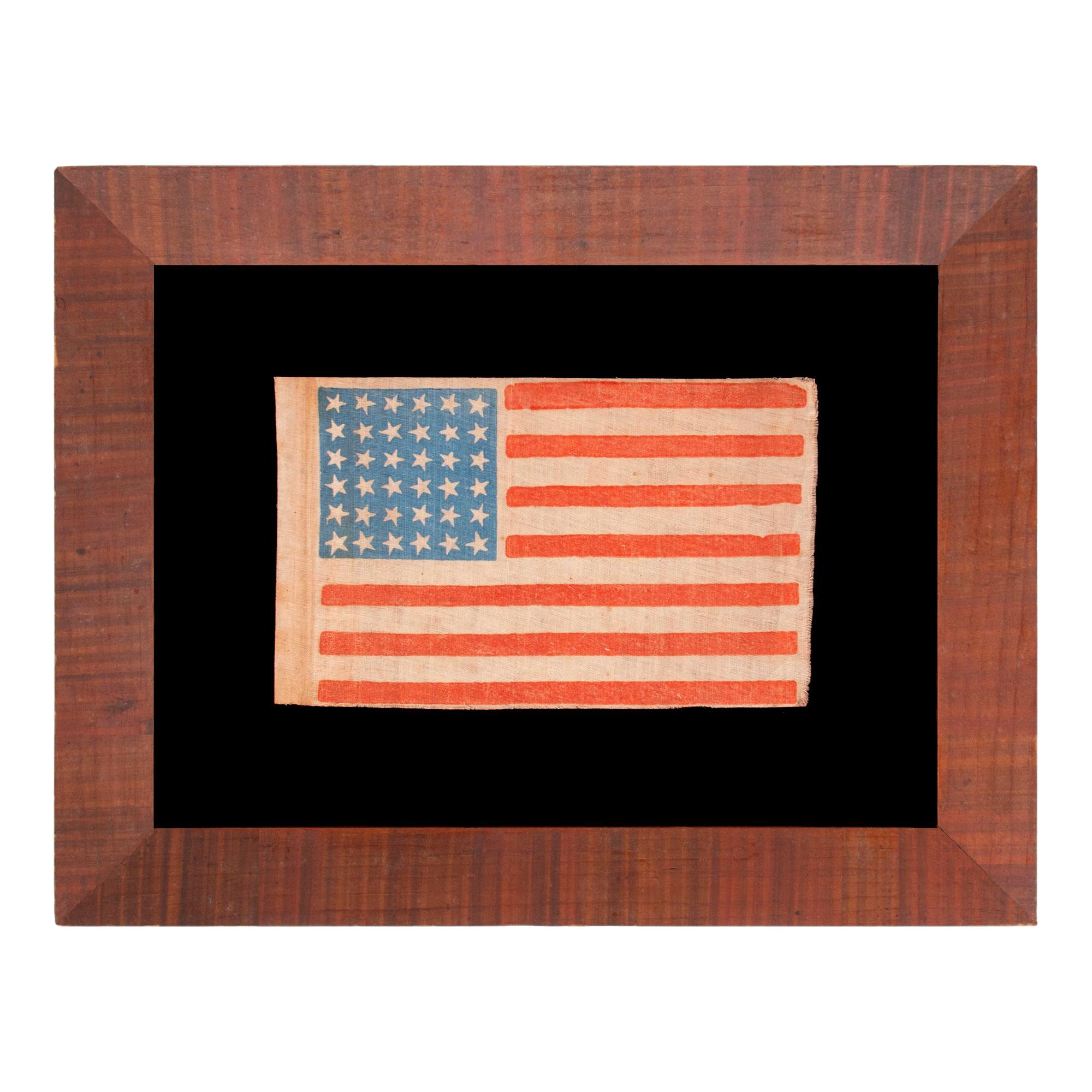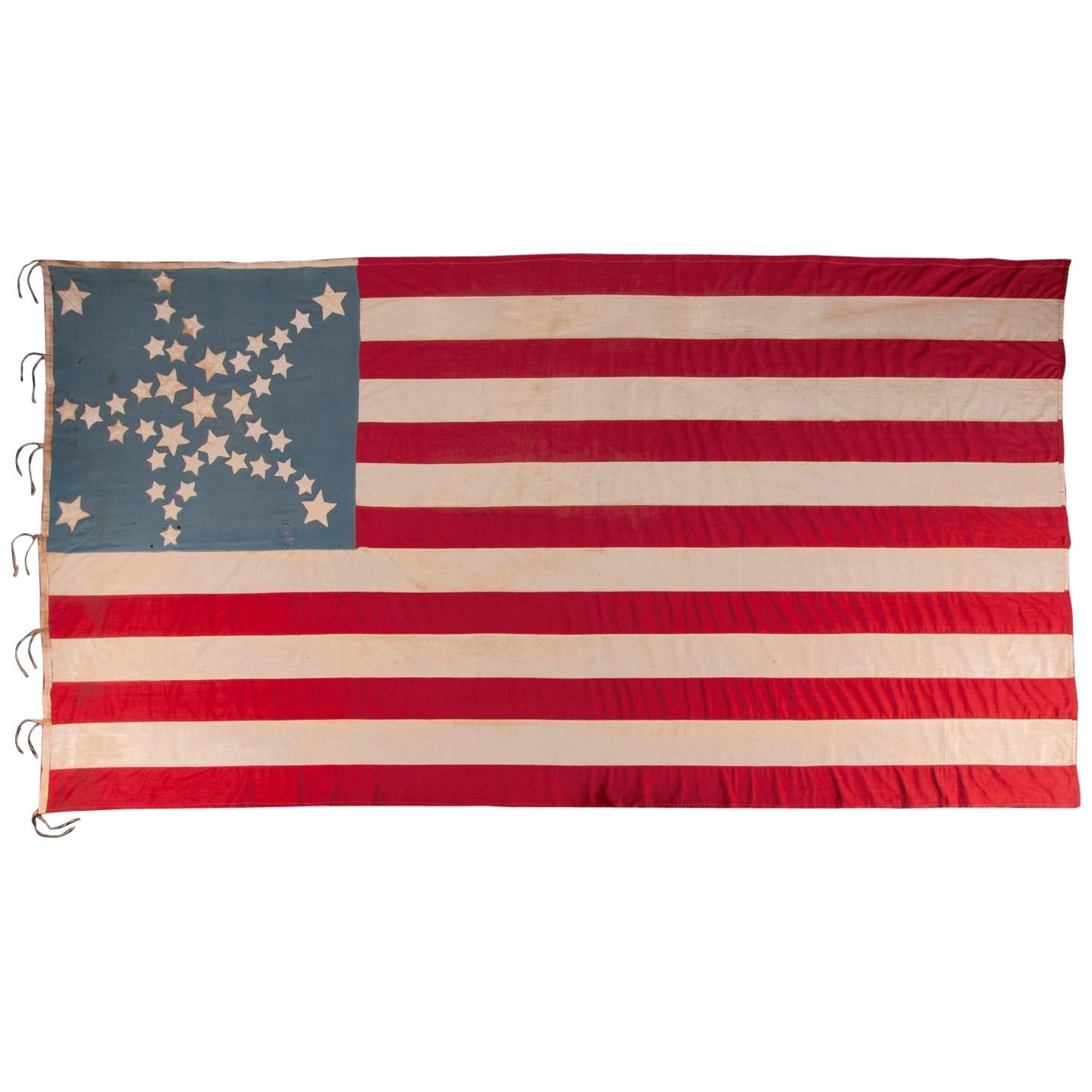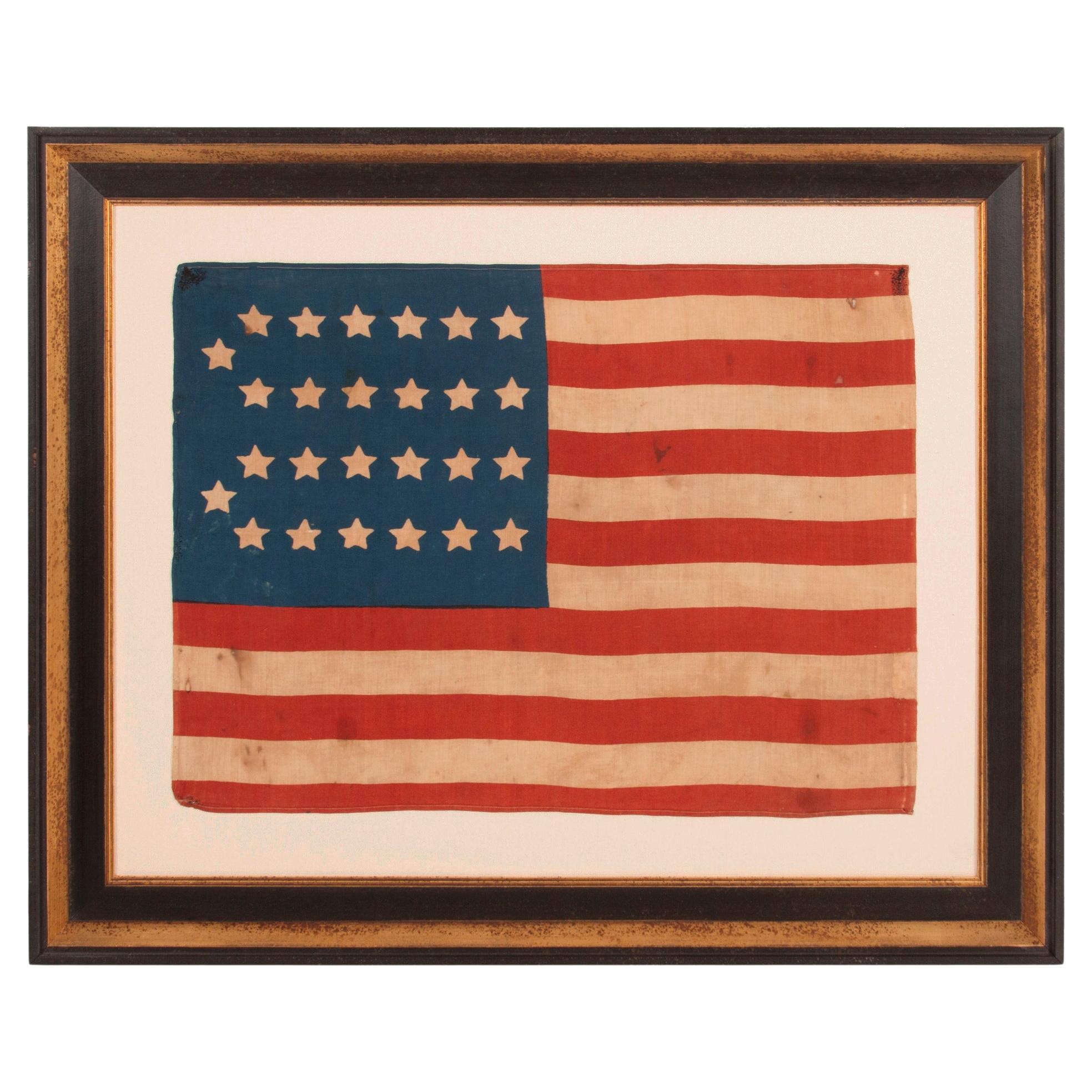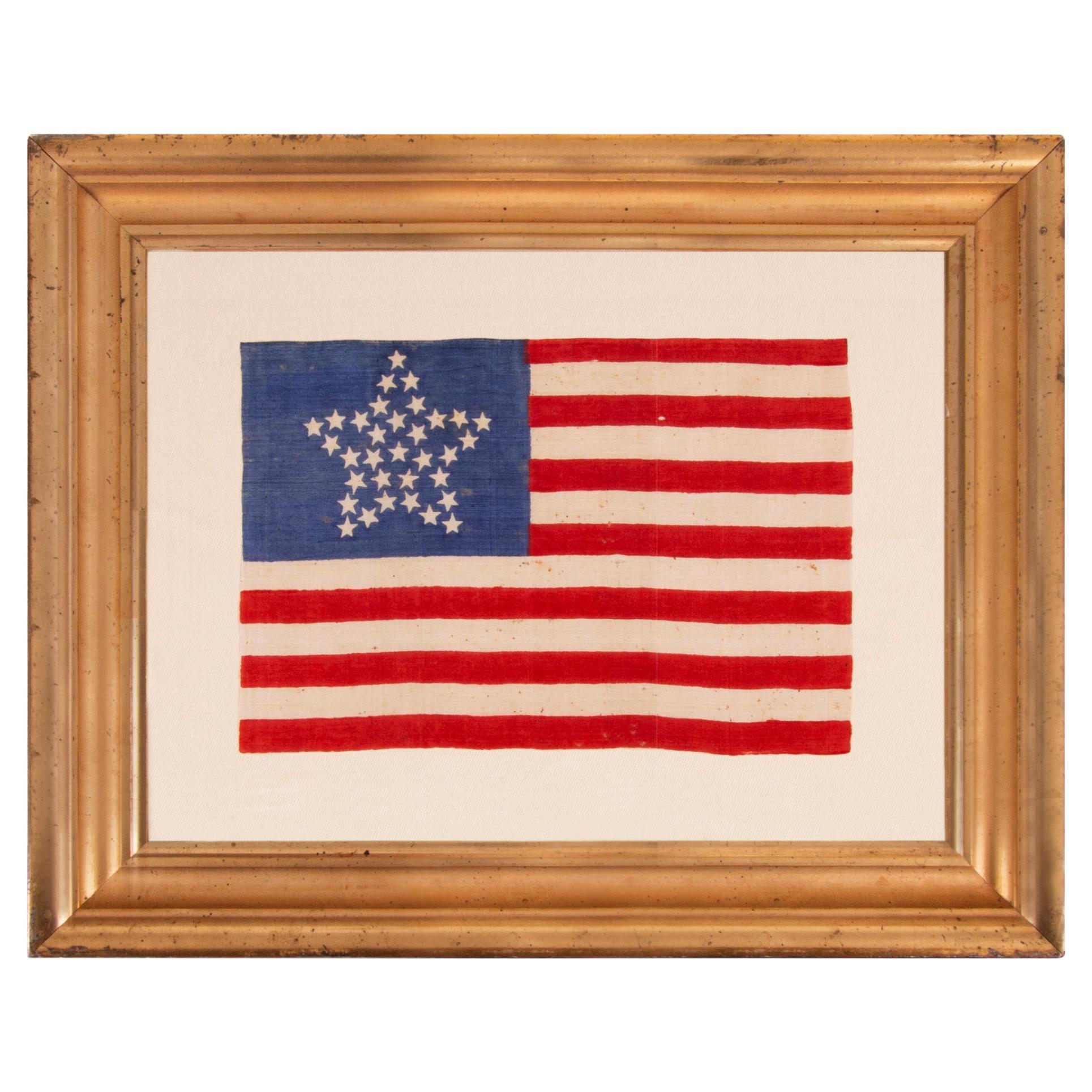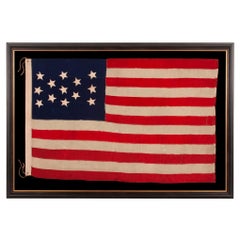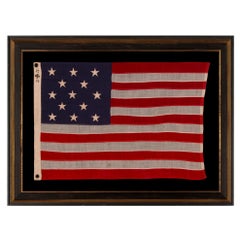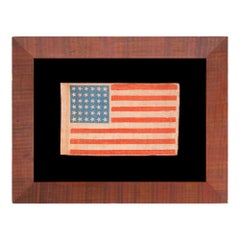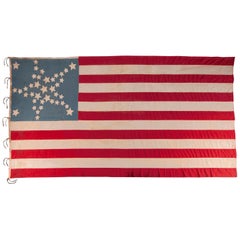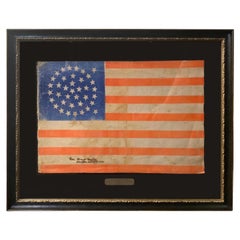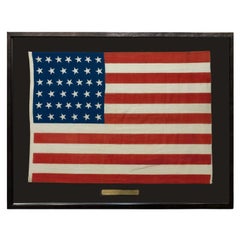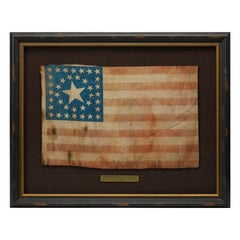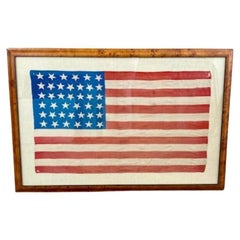Items Similar to 13 Stars on a flag Made for the 1840 Presidential Campaign of W.H. Harrison
Want more images or videos?
Request additional images or videos from the seller
1 of 8
13 Stars on a flag Made for the 1840 Presidential Campaign of W.H. Harrison
Price Upon Request
Price Upon Request
Price Upon Request
Price Upon Request
Price Upon Request
Price Upon Request
Price Upon Request
Price Upon Request
Price Upon Request
Price Upon Request
Shipping
Retrieving quote...The 1stDibs Promise:
Authenticity Guarantee,
Money-Back Guarantee,
24-Hour Cancellation
About the Item
13 STARS ON A FLAG MADE FOR THE 1840 PRESIDENTIAL CAMPAIGN OF WILLIAM HENRY HARRISON, WITH THE INCLUSION OF A THREE-COLOR PORTRAIT MEDALLION, IN VIOLET , GOLD, AND BLACK; AMONG THE EARLIEST OF ALL PRINTED FLAGS KNOWN TO EXIST; REFLECTS THE VERY FIRST NOMINEE FOR WHOM PRESIDENTIAL CAMPAIGN PARADE FLAGS WERE MADE
In early America it was considered in poor taste for presidential candidates to campaign for public office. Various objects were created to show support for Andrew Jackson in both 1828 and 1832, and there are rare exceptions for other political figures, but the material produced for 1840 Whig nominee William Henry Harrison is generally the earliest to have been rendered in any significant quantity for campaign advertising.
The Whig Party drew on nicknames and memorable slogans, as well as strong visual symbols, to promote their candidate as a war hero and man of the people. The largest and most colorful objects were generally in the form of banners, kerchiefs and flags. Banners were generally hand-painted, while kerchiefs and flags were generally produced by commercial printers in cottage industry settings. Commonly referred to as parade flags or hand-wavers, and designed in the form of the Stars & Stripes, the flags made for Harrison's groundbreaking campaign are actually the very first printed versions of our national colors known to exist. While others of the same era are known without campaign advertising (having 26 stars, accurate from 1837-1844), the earliest that can be dated to a specific year are Harrison's 1840 examples.
Printed on silk, the flag's 13 stars are configured in a circular version of what is known as the "3rd Maryland" pattern. This beautiful and desirable design consists of a wreath of 12 stars, with a large star in the very center. The star count pays homage to the American Revolution, the founding of our nation, and its struggle for freedom. All known varieties of W. H. Harrison campaign parade flags have 13 stars, save one, which has either 25 or 26 stars, depending on how they are counted. Two stars appear in the center of the design, including one large white star, with a smaller blue one inside it. The correct count of the latter flag is probably meant to be 26, because 1840 fell squarely within the 26 star period (1837-1845).
Harrison’s honorary title, “Hero of Tippecanoe”, is printed in black pigment in the 4th and 5th stripes. Our nation's 9th president had a successful military career and is most famous for overcoming a feared confederacy of American Indian tribes--the first and only of its kind during the 19th century, organized by American Indian chief, Tecumseh and his brother, Tenskwatawa. Fending off a surprise attack, launched when he arrived for peace talks at the Native American city of Prophetstown, on the banks of the Tippecanoe River, Harrison and his troops went on to destroy the encampment, which served as the primary base for the combined Indian forces. After this he gained the nickname “Old Tippicanoe”. Campaign slogans are present on approximately 10% of all known presidential campaign parade flags, and this small percentage are among the most scarce. In other words, slogans are not only rare on parade flags, but those styles that do have slogans are often one-of-a-kind or one of a scant few in that exact form.
The flag's most important feature, however, can be found within the open oval window in the striped field. This contains an bust portrait of the general, governor, congressman, senator, and soon-to-be president, dressed in military garb. The image appears beneath arched letters announcing his name and title, "Gen. Wm. H. Harrison," and 13 stars, placed 6 to the left and 7 to the right. A wreath of laurel leaves surrounds the portrait and text, with a whimsical bow at the bottom center.
The most unusual thing about the portrait on this particular style of flag is the use of additional colors. While the entire outline is executed in black, Harrison's uniform is overprinted in gold and violet, with his scarf in a lighter version of the latter hue. The wreath is particularly wonderful, in alternating use of the two colors. No other campaign flags, besides Harrison's in 1840, contain portraits that are multi-colored; and while one other colored Harrison portrait variety is known in a different style, no copies of that flag are known in which the colors are still vibrant.
Beyond 1840, use of 6 colors (including the white of the fabric) on a portrait or word flag made for presidential campaigning is unknown. The nearest instance is a 5-color variety. Made for the 1876 presidential run of Rutherford B. Hayes, this features a portrait of Lady Columbia, flanked by an eagle and a federal shield. Only one copy of that flag is known.
Also note how the flag's proportions are nearer to square than most examples. Flags in this basic style were produced for both the 1840 and 1844 campaigns in particular. The square format may have served so that the flag could be just as easily flown on a staff, or tied like a kerchief. In any event, many of the earliest examples bear this square profile, that mimicked the shape of infantry battle flags.
Another aspect of interest in this style of flag is its bold size. At approximately 28 x 29 inches, it is notably larger than most of its counterparts with political advertising.
Similar examples of this flag are documented in “Threads of History, Americana Recorded on Cloth, 1775 - the Present”, by Herbert Ridgeway Collins (1979, Smithsonian Press). Some have different star patterns. Some have different verbiage. Some have different portraits and or other images in place of a portrait. Some of these have a number of stripes greater than 13. This particular flag is a combination of items 134 and 135 on page 102. This is a 13 stripe version, as illustrated in item 134, but with the square canton and circular configuration of stars instead of oval, as illustrated in 135. The printing of the text and the last stripe, as well as the weave of the fabric, and the angle at which the last stripe is printed, is so similar in item 134 to the flag in question here, that the two were almost certainly from the same bolt of fabric, printed with the same plates. The most significant disparity between the two lies in the extremely wide red stripe along the top of the flag that is the subject of this narrative, which adds yet another interesting element to its unusual, visual qualities.
I believe all of the flags in this basic style to have been produced by the same maker—yet unidentified—actively producing examples for Whig Party candidates in both the election years of 1840 and 1844, swapping print blocks for cantons, text, and copperplate images for the central medallion. It seems as though there was an attempt to make as many of the flags as unique as possible, perhaps so that when a dozen, for example, were sold to one dry goods seller, they would be varied throughout. Whatever the case may be, those that survive fall not only among the earliest, but the most interesting of all printed versions of the Stars & Stripes.
Brief Notes on William Henry Harrison and the 1840 Presidential Election:
William Henry Harrison (b. Feb. 9th, 1773) was the son of wealthy plantation owner Benjamin Harrison V, who had been a delegate to the second Continental Congress, signer of the Declaration of Independence, and Governor of Virginia.
Following the death of his father, in 1791, at the age of 18, the former General Henry "Light Horse" Lee, convinced William to join the army. He was sent to Cincinnati and participated in the Indian War, where he achieved much success and reputation, was promoted to Lieutenant, then aide-de-camp. He signed the treaty to end the war and in 1799 was elected to the Sixth United States Congress, which met in Philadelphia from March 4 of that year until March 4, 1801. In 1799, at age 26, he was also selected as the first delegate representing the Northwest Territory. He served this position from 1799 to 1800, having no authority to vote on bills but was permitted to serve on a committee, submit legislation, and debate. In this capacity he successfully promoted the passage of the Harrison Land Act, which made it easier for the average settler to buy small parcels of land in the Northwest Territory. In 1800 the territory was split in two to become the Ohio and Indiana Territories. Without informing Harrison, President John Adams nominated him to become governor of the Indiana Territory (1802), based on his ties to the area and neutral political stances. Harrison was confirmed by the Senate the following day. Caught unaware, Harrison accepted the position, yet only after receiving assurances from the Jeffersonians that he would not be removed from office after they gained power in the upcoming elections.
Harrison's primary duties as territorial governor involved military action and negotiations with Native Americans. He continued to serve in the Northwest Territories during the War of 1812, then bought land in Ohio, where he became a United States Congressman (1816-1819), then an Ohio State Senator (1819-1821), then a U.S. Senator (1824-1828).
In 1840 the Whigs used various campaign tactics to portray Harrison as a commoner. His, opponent, incumbent President Martin Van Buren, was a New Yorker with an aristocratic air. This combined with an economic depression that included the devastating collapse of the Second National Bank of the United States, subsequently lost him the election.
Harrison was the last U.S. president to have been born under the British monarchy. At age 68, he was the oldest president elected to date, inspiring over 80% voter turnout. Today he is best remembered for serving the shortest term in the history of the American presidency. To prove he was not elderly and feeble, he gave a record-breaking hour-and-forty-five minute inauguration speech in freezing rain. Forgetting a topcoat, he then greeted guests and remained outdoors for a prolonged period. He subsequently caught pneumonia and died just 32 days after taking office. Vice President, John Tyler, was chosen for the ticket because he was a Southerner and thus balanced the interests of slave owners. Tyler finished out his 4-year term but was generally unsuccessful in the White House, unpopular, and did not seek reelection.
Election Results:
William Henry Harrison, Ohio (Whig) - 52.9% PV, 234 EV
Martin Van Buren, New York (D) - 46.8% PV, 60 EV
Mounting: The flag was mounted and framed within our own conservation department, which is led by expert trained staff. We take great care in the mounting and preservation of flags and have framed thousands of examples.
The background is 100% cotton, black in color, that has been washed and treated for colorfastness. The mount was then placed in a dark brown, concave molding with a grain like mahogany, to which an exceptional and substantial, shadowbox style, gilded molding was added as a cap. The glazing is U.V. protective acrylic (Plexiglas).
Condition: There are tiny tack holes along the hoist end, where the flag appears to have been affixed to a wooden staff, and there are a couple of very tiny holes elsewhere. There is minor foxing and staining in limited areas throughout, the most significant of which is at the fly end of the first red stripe. None of this is particularly notable. There is moderate fading of the red dye to a rust red-brown coloration, typical of red pigments employed in flags and kerchiefs of this era.
Frame Size (H x L): 40" x 39.25"
Flag Size (H x L): 28.75" x 28.25"
- Dimensions:Height: 40 in (101.6 cm)Width: 39.25 in (99.7 cm)Depth: 2.5 in (6.35 cm)
- Materials and Techniques:
- Place of Origin:
- Period:1840-1849
- Date of Manufacture:1840
- Condition:
- Seller Location:York County, PA
- Reference Number:Seller: 13j-16491stDibs: LU849742071332
About the Seller
5.0
Recognized Seller
These prestigious sellers are industry leaders and represent the highest echelon for item quality and design.
Established in 1991
1stDibs seller since 2008
70 sales on 1stDibs
Typical response time: 1 to 2 days
- ShippingRetrieving quote...Shipping from: York County, PA
- Return Policy
Authenticity Guarantee
In the unlikely event there’s an issue with an item’s authenticity, contact us within 1 year for a full refund. DetailsMoney-Back Guarantee
If your item is not as described, is damaged in transit, or does not arrive, contact us within 7 days for a full refund. Details24-Hour Cancellation
You have a 24-hour grace period in which to reconsider your purchase, with no questions asked.Vetted Professional Sellers
Our world-class sellers must adhere to strict standards for service and quality, maintaining the integrity of our listings.Price-Match Guarantee
If you find that a seller listed the same item for a lower price elsewhere, we’ll match it.Trusted Global Delivery
Our best-in-class carrier network provides specialized shipping options worldwide, including custom delivery.More From This Seller
View All13 Star Antique American Flag with a Narrow Star Presentation, ca 1876
Located in York County, PA
13 STAR ANTIQUE AMERICAN FLAG WITH HAND-SEWN STARS IN AN EXTREMELY NARROW PRESENTATION OF A 3-2-3-2-3 ARRANGEMENT ON A CANTON THAT DOESN’T FOLLOW SUIT, LEAVING WIDE EXPANSES OF BLUE ...
Category
Antique 1870s American Political and Patriotic Memorabilia
Materials
Wool
Price Upon Request
13 Star Antique American Flag, Inscribed "Spenge" ca 1895-1926
Located in York County, PA
13 STAR ANTIQUE AMERICAN FLAG WITH A 3-2-3-2-3 CONFIGURATION OF STARS ON AN ATTRACTIVE, INDIGO BLUE CANTON; A SMALL-SCALE EXAMPLE OF THE 1895-1926 ERA, INSCRIBED WITH THE SURNAME “SP...
Category
Antique Late 19th Century American Political and Patriotic Memorabilia
Materials
Wool
36 Star Antique American Parade Flag, with Canted Stars, ca 1864-1867
Located in York County, PA
36 STAR ANTIQUE AMERICAN PARADE FLAG WITH CANTED STARS IN DANCING ROWS, ON A BEAUTIFUL, CORNFLOWER BLUE CANTON; CIVIL WAR ERA, NEVADA STATEHOOD, 1864-1867
36 star antique American f...
Category
Antique 1860s American Political and Patriotic Memorabilia
Materials
Cotton
Price Upon Request
34 Star American flag, Updated to 39 Stars, with Stars in a Great Star Pattern
Located in York County, PA
34 STARS IN A WHIMSICAL RENDITION OF THE GREAT STAR PATTERN, ON A CIVIL WAR PERIOD FLAG WITH A CORNFLOWER BLUE CANTON, UPDATED TO 39 STARS IN 1876
34 star American national flag with additional stars added and one of the most stunning graphic designs I have ever seen in early flag-making. The original pattern was comprised of a circle of 5 large stars, and triangular arms made of smaller stars. These are noticeable pointy and bent like the arms of a starfish. Made of cotton, the stars are hand-sewn and double-appliquéd to a fantastic, cornflower blue canton, a color common to Civil War uniforms...
Category
Antique 1870s American Political and Patriotic Memorabilia
Materials
Cotton
Price Upon Request
Free Shipping
26 Star Antique American Flag, with 11 Stripes, Michigan Statehood, ca 1837-1846
Located in York County, PA
26 STAR ANTIQUE AMERICAN PARADE FLAG WITH 11 STRIPES AND IT’S CANTON RESTING ON THE “WAR STRIPE.” THE EARLIEST KNOWN STAR COUNT FOR PRINTED EXAMPLES, 1837-1846, MICHIGAN STATEHOOD
2...
Category
Antique Mid-19th Century American Political and Patriotic Memorabilia
Materials
Cotton
33 Star Antique American Flag with a Great Star Configuration, ca 1859-1861
Located in York County, PA
33 STARS ANTIQUE AMERICAN FLAG WITH A "GREAT STAR" CONFIGURATION ON A BRILLIANT, INDIGO BLUE CANTON, A RARE AND EXTRAORDINARY EXAMPLE, PRE-CIVIL WAR THROUGH THE WAR'S OPENING YEAR, 1...
Category
Antique Late 19th Century American Political and Patriotic Memorabilia
Materials
Silk
You May Also Like
38-Star American Parade Flag, Flown at a Reception for President Grant, 1880
Located in Colorado Springs, CO
This is a beautifully colored 38-star American parade flag, flown at a public reception for Ulysses S. Grant in October of 1880. This printed flag features a rare, triple medallion s...
Category
Antique 1880s American Political and Patriotic Memorabilia
Materials
Cotton
39-Star Antique American Flag with 'Whimsical' Star Pattern, 1889
Located in Colorado Springs, CO
This is a 39-star unofficial American flag, handmade and printed on cotton. The flag dates to 1889 and has a unique history, thanks to its rare star-count.
The flag’s canton is prin...
Category
Antique 1880s American Political and Patriotic Memorabilia
Materials
Cotton
38-Star Antique American Flag with Unique Canton, circa 1876-1890
Located in Colorado Springs, CO
This is a striking 38-star American flag. The flag dates to 1876-1890, when Colorado (represented by the large star in the center of the flag’s canton) joined the Union as the 38th s...
Category
Antique Late 19th Century American Political and Patriotic Memorabilia
Materials
Muslin
19th Century American 39 Star Flag, circa 1889
Located in Nantucket, MA
19th Century American 39 Star Flag, circa 1889, a period printed silk parade flag with a wavy pattern of dancing stars. This was never an official flag of the United States but was m...
Category
Antique 1880s American Federal Political and Patriotic Memorabilia
Materials
Silk
31-Star Printed American Flag, Celebrating California Statehood, Circa 1850
Located in Colorado Springs, CO
This is a rare 31-star medallion printed American flag, celebrating the addition of California to the Union. The flag is printed on silk and has a spectacular “Great Star” canton pat...
Category
Antique 1850s American Political and Patriotic Memorabilia
Materials
Silk
19th Century 39 Star American Flag, circa 1889
Located in Nantucket, MA
19th Century 39 Star American Flag, circa 1889, a printed linen ensign with 39 stars arranged in a wavy star pattern, with stripes in a very unus...
Category
Antique 1880s American Federal Political and Patriotic Memorabilia
Materials
Linen
More Ways To Browse
Folk Art Train
19th Century American Flag
Antique Gold Silk Fabric
Dior Stripe
Horses Memorabilia
William Shields
Small American Flag
Antique American Flag Framed
Lost Profile
Rust Gold Brown Art
80s Style Dresses
Indian Arch
Red Dress With Train
Antique Indian Chief
Antique Wooden Oval Frames
H W B And Sons
Gilded Age Antiques
Dior Lighter
